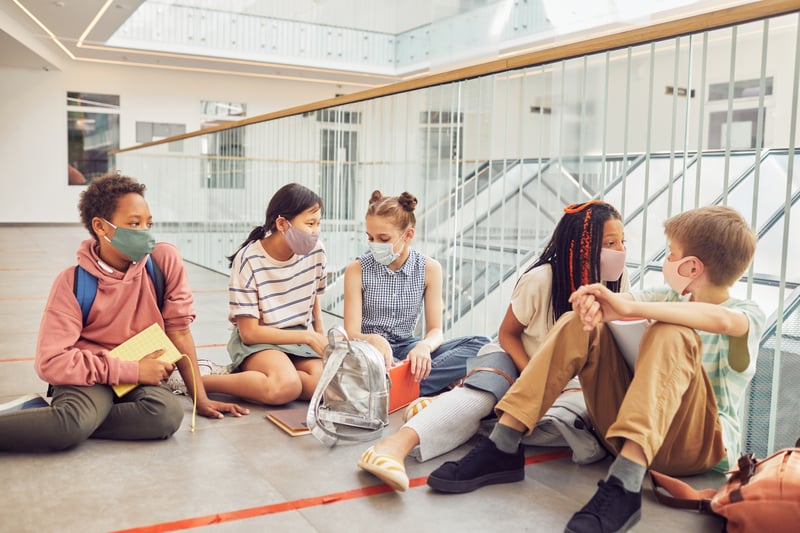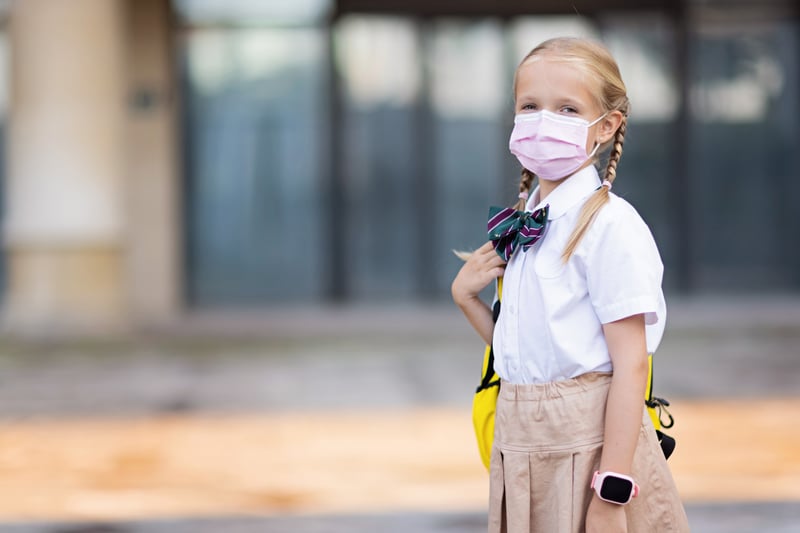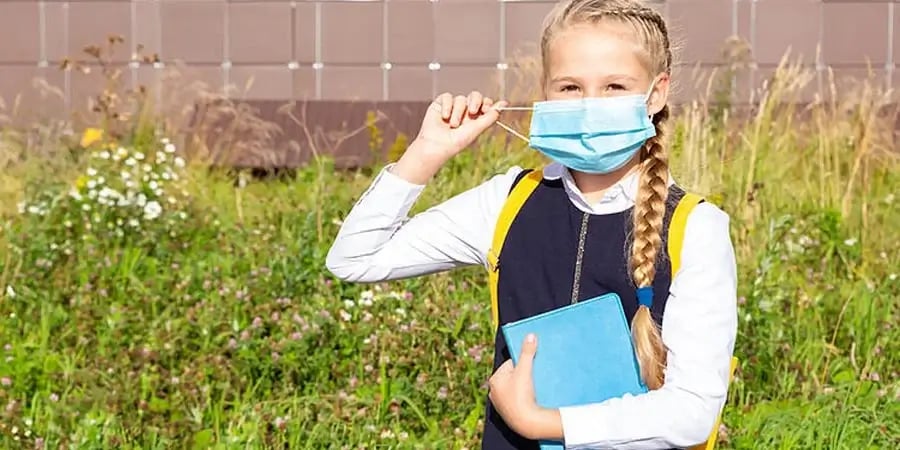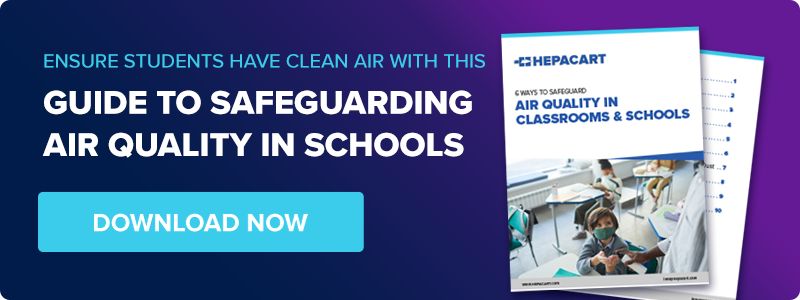Share this
How School Air Quality Affects Students
by HEPACART on May 24, 2022
The better the air, the better the school performance.
There’s a reason that people go outside to get “fresh air.” Indoor air quality can often be worse than outdoor air with 2 to 5 times the pollutants, and even up to 100 times the pollutants! Even though it’s impossible to see these air contaminants, they can be responsible for coughing, sneezing, headaches, allergic reactions, and even worsened asthma attacks. This last point is especially important regarding air quality in classrooms since the EPA estimates that 1 in 13 students has asthma. Increased allergen levels in the air can lead to these students (and staff members, if they have asthma) having decreased cognitive function and increased absenteeism.
School Air Quality in General
It’s not just asthma sufferers who are impacted by allergen and contaminant levels in the air, it can be anyone! Even carbon dioxide, or CO2, in high amounts, can impair brain function. Mites and bacteria thrive in humid, untreated air, and only exacerbate unpleasant reactions on the part of school occupants. In fact, clean air has been directly linked to increased test scores in students.
The problem can’t just be solved by pumping outside air in and inside air out, either. Another study that examined schools that were downwind or upwind of heavy traffic found a correlation between pollution levels and test scores and behavior issues. Those schools that experienced more pollution were, of course, the ones that had more problems.
What Causes Poor School Air Quality?

When looking for ways to solve the school air quality problem, the underlying causes have to be addressed first. Schools that are downwind of a pollutant source can’t do much to address their location, but they can address indoor air quality (IAQ) by attacking common issues.
1. HVAC Systems
Because many school buildings are aging (more on this in a minute), the original HVAC systems were designed to handle only so many people. Even if the individual AC units themselves have been replaced over the years, the ductwork may be inadequate to handle the space. Whether due to restricted air paths or a buildup of contaminants through years of deferred cleaning, HVAC systems can cause harm by not pumping enough air, leaving rooms stale and humid, or pumping contaminated air around the building.
2. The Students/Faculty Themselves
People are excellent transmitters of contaminants! From germs and bacteria that are breathed in and then out in various locations, to allergens and dust that cling on and let go randomly, the people that need protection from pollutants are also carriers. Even masks, effective as they are at preventing the spread of inhaled/exhaled microbes, can’t completely eradicate these indoor contaminants from making their way around from person to person.
3. Off-Gassing
This is a term that refers to chemicals that evaporate from a surface and make their way into the air. These gasses can come from cleaning products or from poor-quality materials that aren’t sealed properly. They can even enter the air as a result of construction projects, such as newly installed carpets or vinyl flooring. Such gasses can continue to enter the air for years.
4. Old Buildings
In addition to the HVAC woes that can befall an older building, the infrastructure can be compromised to the point where harmful materials are beginning to leak. Water damage is common, as are cracks in the structure. Asbestos has been highly publicized, and while it’s a problem, it’s not the only problem. Mold, dust, and construction materials can also cause unpleasant reactions.
How Can Air Quality in Classrooms Improve?
We wouldn’t mention these issues unless there were solutions. So, how can you reverse course and begin making classroom air the cleanest air possible?
1. Replace/Clean HVAC Systems
It’s time for old HVAC systems to go. If the ducting is inadequate for airflow, it must be added, expanded, or replaced. You may have to have it cleaned, as well. Filters are essential to keeping an HVAC system running properly, and they’ll have to be replaced on a regular schedule.
2. Student/Faculty Health Policies
For hospitals, this may be the most important factor. Construction dust and debris can contain some nasty stuff you don’t want your patients or staff to breathe. With RealWalls, you can set up a completely sealed barrier to protect the people in your hospital without inconveniencing the construction crew.
3. Change Cleaning Products/Materials
Look for cleaning products that off-gas the least and clean at the most opportune times to avoid exposure to large groups of students. When renovating or constructing, find materials that are properly sealed and have the least chance of off-gassing.
4. Upgrade Infrastructure
Seal all leaks in the building, whether they’re leaks in pipes that drip water or air leaks that allow outside air to pass in and out freely.
5. Get HEPA Filters
HEPA filters will be excellent companions on your clean air journey. The great news is that as you address the underlying issues of your school air quality, the HEPA filters won’t have to work as hard to clean the air! HEPA filters are excellent at capturing particles that viruses love to travel on, as well as dust and other pollutants.
HEPAFORCE® GermBuster Air Purifiers Change the Game
Expanding on that last point, HEPAFORCE® GermBusters are an excellent way to keep air quality in check, especially when paired with UV-FORCE® Far-UVC virus destroying lamps. They can disinfect the air in a room of 3,200 cubic feet, 6 times per hour, leading to clean, easy breathing air in your classrooms. For larger areas of 6,400 cubic feet, it will still clean the air 3 times per hour! Plus, all controls for the unit stay behind a locked panel to prevent tampering.
Our Guide to Improving Classroom IAQ

Because children breathe more air for their size than adults, their air quality must be protected more than anyone’s. We’ve put together a downloadable guide that gives you 6 Ways To Safeguard Air Quality in Classrooms & Schools so you can make informed decisions about your school’s air quality. HEPAFORCE products keep air safe all around the world, and we can do the same for you and your school.
Resources:



